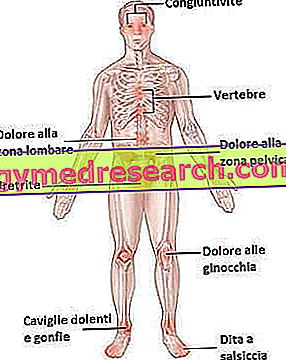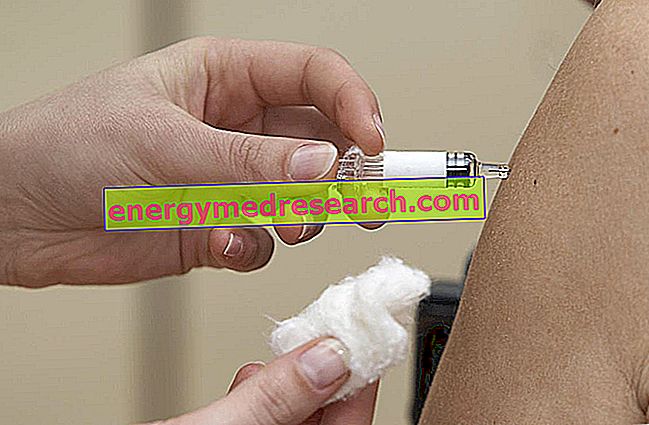Generality
Reiter's syndrome is a disease of infectious origin characterized by a triad of inflammatory processes: arthritis, conjunctivitis and urethritis. The onset of these inflammatory processes is linked to a bacterial infection, followed by a sudden malfunction of the immune system; among the most often involved etiological agents are chlamydia and shigella.

Figure: the main symptoms of Reiter's syndrome. From the site: www.rheumatology.org
When the inflammatory process is limited to the joints, Reiter's syndrome is called reactive arthritis.
An objective examination of the patient, an accurate analysis of the blood and, if necessary, some radiological checks are necessary for the doctor to establish the correct diagnosis.
Although there is no specific treatment, with the administration of anti-inflammatories and antibiotics it is possible to alleviate a large part of the symptoms and prevent a possible relapse.
What is Reiter's syndrome?
Reiter's syndrome is an inflammatory disease of infectious origin, which affects the joints, eyes and urethra. On the other hand, when inflammation is limited to the joints, one speaks more correctly about reactive arthritis .
The infectious agents that contribute to triggering Reiter's syndrome are bacteria acting on the genital, intestinal and urinary levels.
THE INFLAMMATION SEATS
Inflammation of the joints is called arthritis ; that of the eyes is called conjunctivitis ; finally, the inflammatory state concerning the urethra is called urethritis .
Each of these inflammatory processes presents with particular symptoms, treated in more detail in the dedicated chapter.
Epidemiology
Reiter's syndrome and reactive arthritis are two uncommon diseases: both, in fact, have an incidence that is equal to about one case per 2500 people.
The inflammatory form triggered by intestinal infections occurs with the same number of cases in both sexes. In contrast, the inflammatory form caused by genital tract infections is more common among men.
The subjects most affected are individuals aged between 20 and 40; however, it is not excluded that children and the elderly may also become ill.
Causes
The exact cause of Reiter's syndrome (as well as reactive arthritis) is not yet completely known. The most accepted hypothesis is the following.
To initiate the inflammatory process, two conditions must occur:
- The first is the infection of the organism by specific bacteria, which act at the intestinal, urinary or genital level. The bacterial microorganisms in question are: chlamydia, salmonella, shigella, yersinia and campylobacter .
- The second is the malfunction of the immune system of the infected organism. As it happens in autoimmune diseases, after a few weeks from the infection, the immune system inexplicably attacks also organs and tissues of the human organism.
Although bacterial infection plays a very important role, the real protagonist in Reiter's syndrome is precisely the immune system and its anomaly. Without this malfunction, in fact, the pathogen, for example chlamydia, would do nothing but provoke its classic symptomatology, without causing any joint inflammation, etc.
Bacteria involved and transmission methods:
- Chlamydia (sexual transmission)
- Salmonella (fecal-oral transmission)
- Sighella (fecal-oral transmission)
- Yersinia (fecal-oral transmission)
- Campylobacter (fecal-oral transmission)
IS THERE A THIRD CONDITION?
According to some researchers - in addition to infection and immune malfunction - there is a third genetic condition.
Indeed, some studies have shown that Reiter's syndrome and reactive arthritis are more common in individuals carrying the HLA-B27 gene in their DNA. In the UK, for example, three out of four people with the aforementioned gene develop the disease or symptoms very similar to it.
The exact mechanism by which the HLA-B27 gene acts is not yet clear.
IS REITER'S SYNDROME CONTAGIOUS?
Reiter's syndrome and reactive arthritis result from bacteria that are transmitted by sexual means and through contaminated foods (via the fecal-oral route). This does not mean, however, that it is a contagious disease, as the subjective immune element is decisive.
Symptoms and Complications
To learn more: Symptoms of Reiter's Syndrome and Reactive Arthritis Symptoms
Reiter's syndrome causes three different types of inflammation:
- Arthritis, joints and tendons
- Conjunctivitis, in the eyes
- Urethritis, urinary tract
The symptoms and signs of Reiter's syndrome are typical of these three inflammatory processes and appear 2-4 weeks after bacterial infection.
As anticipated, reactive arthritis is limited to the joints.
ARTHRITIS
Arthritis causes pain and swelling in the large joints, ie knee, hips and ankles. Very often, the painful sensation is also felt in the lumbar area, the buttocks, the vertebrae and the heels.
Although it does not happen to all patients, it is possible for the fingers and toes to swell, assuming the "sausage" appearance.
CONJUNCTIVITIS

Figure: signs of conjunctivitis due to Reiter's syndrome. From the site: www.amsn.com.au
The signs and symptoms of conjunctivitis are: eye redness, eye pain, intense tearing and swelling of the eyelids.
In some rare cases, a particular uveitis, called iritis, may develop, which consists of an inflammation of the iris. The patient suffering from iritis has pain and redness in the eyes, as well as sensitivity to light ( photophobia ).
urethritis
The symptoms and signs of urethritis are numerous: pain and burning during urination, need to urinate often and urgently, loss of fluid from the penis or vagina and, more rarely, blood in the urine.
OTHER SYMPTOMS
Next to the aforementioned symptomatology (which is the main one), the patient with Reiter's syndrome and reactive arthritis may present other, less characteristic symptoms:
- Unusual feeling of fatigue
- Mild fever, between 37 ° C and 38 ° C
- Buccal ulcers
- Small white patches in the mouth (mouth ulcers) painless
- Skin rash
- Thick and brittle nails
- Abdominal pain
- Attacks of diarrhea
WHEN TO REFER TO THE DOCTOR?
The most important symptoms, to which maximum attention should be paid, are pain and joint swelling and sudden problems during urination.
COMPLICATIONS
The only noteworthy complication is chronic or persistent arthritis, which occurs due to an approximate cure and to neglect of symptoms.
Diagnosis
To establish the diagnosis of Reiter's syndrome with certainty, a physical examination, blood tests and radiological tests are required.
EXAMINATION OBJECTIVE
The doctor begins the physical examination by asking the patient how the symptoms have arisen and for how long he has been hearing them. It is important that the patient tries to remember the recent past; for example, it may be important to know if you have eaten uncooked food or have had unprotected sex.
After that, the doctor proceeds to the evaluation, in first person, of painful joints, red eyes (in the case of Reiter's syndrome) and unusual skin appearance.
BLOOD ANALYSIS
The blood of a patient with Reiter's syndrome and reactive arthritis has peculiarities, which can be evidenced by certain tests.
So-called erythrocyte and C-reactive protein ( PCR ) sedimentation tests show whether inflammation is taking place in the body or not, while specific antibodies are sought (against the bacteria involved in the disease and those associated with arthritis rheumatoid) helps clarify whether or not there was a bacterial infection in the recent past and whether joint pain is actually due to Reiter's syndrome or not.
Blood tests, therefore, are very advantageous: with a simple withdrawal, you can get a lot of useful information.
How to understand, from a blood test, that there is an inflammation? The erythrocyte sedimentation test consists of measuring how long it takes the red blood cells to fall to the bottom of a test tube, which contains them. The faster this movement (called sedimentation), the more probable an inflammation is underway in the organism under examination. The C-reactive protein (or PCR) test is based on the quantification of this protein, produced by the liver. If inflammation is occurring, PCR levels are higher than normal. | Blood tests:
|
RADIOLOGICAL TESTS
Through radiological examinations, the doctor gets clear images of the large joints (knee, ankles, etc.) and adjacent areas (pelvic area, lumbar area, etc.). If the patient is actually suffering from reactive arthritis, it is possible to note characteristic signs which make it possible to distinguish the disease from other similar joint pathologies.
Treatment
There is no specific treatment for Reiter's syndrome; we must wait for it to heal spontaneously. However, there are therapeutic countermeasures that have the following objectives:
- Relieve symptoms
- Completely eliminate the main bacterial agent from the body
- Protect against future bacterial infections and / or relapses
HEALING TIMES
The healing time varies from 3 to 12 months. The more the diagnosis and treatment are timely, the faster the remission of the disease.
ANTI-INFLAMMATORY
Anti- inflammatories are the most suitable countermeasure to relieve symptoms and moderate the general inflammatory state caused by Reiter's syndrome.
The most widely used drugs are NSAIDs (non-steroidal anti-inflammatory drugs), corticosteroids and antirheumatics.
- NSAIDs, such as ibuprofen, are the most widely used drugs, at least at the beginning, as they give good results without any particular side effects (which are anyway present).
- Corticosteroids are administered if the NSAIDs prove ineffective. They provide excellent results, but should be taken in moderation because they cause numerous side effects (osteoporosis, hypertension, increased body weight, etc.).
- Antirheumatics, such as sulfasalazine or methotrexate, are excellent anti-inflammatories and painkillers, which moderate the response of the immune system (altered in the case of Reiter's syndrome). The main side effects are headache, loss of appetite and feeling of tiredness.
ANTIBIOTICS
Antibiotics are intended to eliminate the bacteria that caused the initial infection from the body. Moreover, if administered periodically even at the end of the therapeutic course, they allow to protect the already healed individual from relapses ( prophylaxis ).
To learn more: Drugs for the treatment of Reiter's Syndrome "
REST, PHYSIOTHERAPY AND EXERCISE
At the beginning of the pharmacological treatment, the doctor advises to stay at rest, to favor a faster recovery from arthritis.
After that, however, he recommends performing physiotherapy, combined with physical exercise . In fact, it is good that the patient regains joint mobility and muscle strength lost due to physical inactivity. It is essential, in these situations, to rely on an experienced physiotherapist who knows the most appropriate rehabilitation path.
Prognosis and prevention
The prognosis, for an individual with Reiter's syndrome (and reactive arthritis), depends, in large part, on when treatment begins.
If diagnosis and therapy are both precocious, healing is rapid and, very often, uncomplicated. Conversely, a late diagnosis postpones the beginning of therapy, compromising the healing process and exposing the patient to complications and relapses.
PREVENTION
To prevent Reiter's syndrome, and reactive arthritis as well, it is important to adhere to the following warnings:
- Use protection and adequate methods of contraception during risky sexual intercourse. This is to prevent the transmission of infections such as chlamydia.
- Store food in clean places and cook it properly, to prevent the spread of bacteria such as salmonella, campylobacter or shigella.
As regards, instead, those who have already contracted Reiter's syndrome, the recommendation is to undergo periodic checks and to the prophylaxis measures recommended by the doctor.



